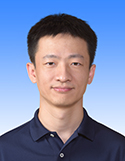
1997.9-2002.6 中国科学技术大学 生命科学院 学士
2002.9-2007.6 中国科学技术大学 生命科学院认知神经心理学专业 博士
2007.11-2012.7 美国明尼苏达大学心理系 博士后及研究助理
2012.7至今 中国科学院心理研究所 研究员
利用心理物理学方法、更改现实技术、脑电、脑功能成像技术以及经颅磁刺激技术,研究视知觉与可塑性,包括眼优势可塑性及弱视治疗,视适应训练,视觉前庭信息整合等。
1. Song F, Dong X*, Zhao J, Wang J, Sang X, He X, Bao M*. (2024). Causal Role of the Frontal Eye Field in Attention-induced Ocular Dominance Plasticity. eLife, 12:RP93213.
2. He X*, Bao M*. (2024). Neuroimaging evidence of visual-vestibular interaction accounting for perceptual mislocalization induced by head rotation. Neurophotonics, 11(1), 015005. doi: 10.1117/1.NPh.11.1.015005.
3. Song F, Lyu L*, Bao M*. (2024). Adaptation of Ocular Opponency Neurons Mediates Attention-induced Ocular Dominance Plasticity. Neuroscience Bulletin, 40(3): 339-349.
4. Dong X, Liu L, Du X, Wang Y, Zhang P, Li Z*, Bao M*. (2023). Treating amblyopia using altered reality enhances the fine-scale functional correlations in early visual areas. Human Brain Mapping, 44(18):6499-6510.
5. Du X, Liu L, Dong X, Bao M*. (2023). Effects of altered-reality training on interocular disinhibition in amblyopia. Annals of the New York Academy of Sciences, 1522(1): 126-138. doi: 10.1111/nyas.14969.
6. Song F, Lyu L*, Zhao J, Bao M*. (2023). The role of eye-specific attention in ocular dominance plasticity. Cerebral Cortex, 33(4): 983-996. doi: 10.1093/cercor/bhac116.
7. Bai J, Bao M*, Zhang T, Jiang Y. (2019). A virtual reality approach identifies flexible inhibition of motion aftereffects induced by head rotation. Behavior Research Methods, 51(1): 96-107.
8. Bao M*, Engel SA. (2019). Augmented reality as a tool for studying visual plasticity:2009 to 2018. Current Directions in Psychological Science, 28(6): 574-580.
9. Bao M*, Dong B, Liu L, Engel SA, Jiang Y. (2018). The best of both worlds: Adaptation during natural tasks produces long-lasting plasticity in perceptual ocular dominance. Psychological Science, 29(1): 14-33.
10. Bai J, Dong X, He S, Bao M*. (2017). Monocular deprivation of Fourier phase boosts the deprived eye's dominance during interocular competition but not interocular phase combination. Neuroscience, 352: 122-130.

